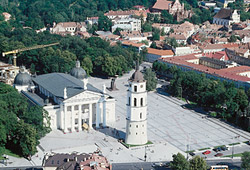History
The first Christian temple is thought to have arisen in this place under King Mindaugas (c.1200-1263), around the year 1251. That church is believed to have been typically medieval, with traits that were more roman than gothic. Archaeologists have found fragments of its floor, which are on display in the crypt of the Cathedral. After the death of Mindaugas, successive rulers fell away from Christianity. For over a century, the church served as a pagan place of worship. It was in 1387, by order of the Lithuanian grand duke and Polish king Jogaila (1348-1434), that construction began here on a gothic cathedral. Dedicated to St Stanislaus and St Vladislaus, it became the episcopal see of the diocese of Vilnius, which was created in 1388. In 1419, a fire destroyed the temple. Grand Duke Vytautas (c. 1350-1430), Lithuania’s ruler at the time, arranged the construction of an imposing new gothic sanctuary. Its main façade included two towers of differing heights. The new Vilnius Cathedral, according to travellers’ accounts, was similar to the main church in the Prussian city of Frauenburg. Here all the Lithuanian grand dukes from Vytautas to Žygimantas Augustas (1520–1572) were crowned. And here some of them were buried, alongside other noblemen and bishops.
Vilnius Cathedral has burned down and been rebuilt or renovated several times. Its current edifice was built at the end of the 18th century at the bidding of Bishop Ignotas Masalskis and according to a design by Laurynas Stuoka-Gucevičius (1753–1798). The well-known architect dressed up part of the old church building in new attire. He kept the gothic floor plan in the new structure, skilfully integrating the Valavičius Family Chapel (also known as the Royal Chapel) at the start of the left nave and, at the end of the right nave, the Chapel of St Casimir, a baroque masterpiece constructed in 1623-1636 under the patronage of King Sigismund III Vasa (1566–1632). The layout of the church is rectangular. In order to achieve symmetry, just opposite the Chapel of St Casimir the architect projected a sacristy of equal size, covered by an identical dome. The statues of St Casimir, St Stanislaus and St Helen that stand atop the Cathedral, at the corners of its front pediment, were originally placed there in the 19th century. They were knocked down during the Soviet era, but replaced in 1997, based on photographs and other visual records.
The Soviet authorities closed Vilnius Cathedral in 1950 and turned it into a warehouse, at first, and later a picture gallery and concert hall. The cathedral was given back to believers in 1988. Vilnius Archbishop Julijonas Steponavičius (1911–1991), whose pastoral work the occupying regime had blocked during many years, presided over the ceremony to rededicate the sanctuary on February 5, 1989.








